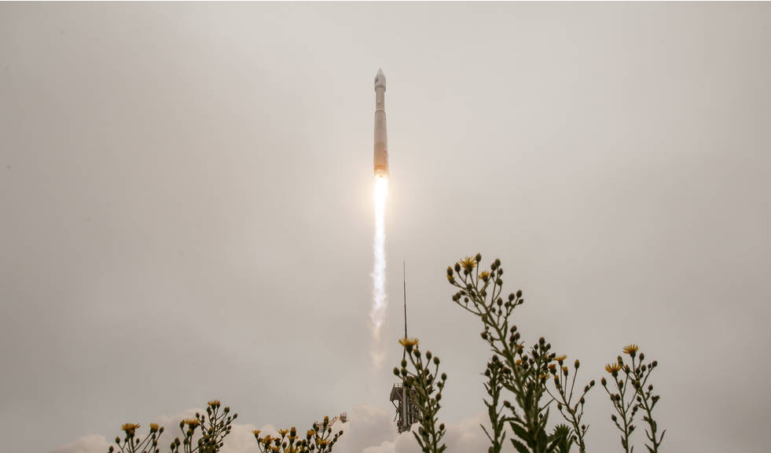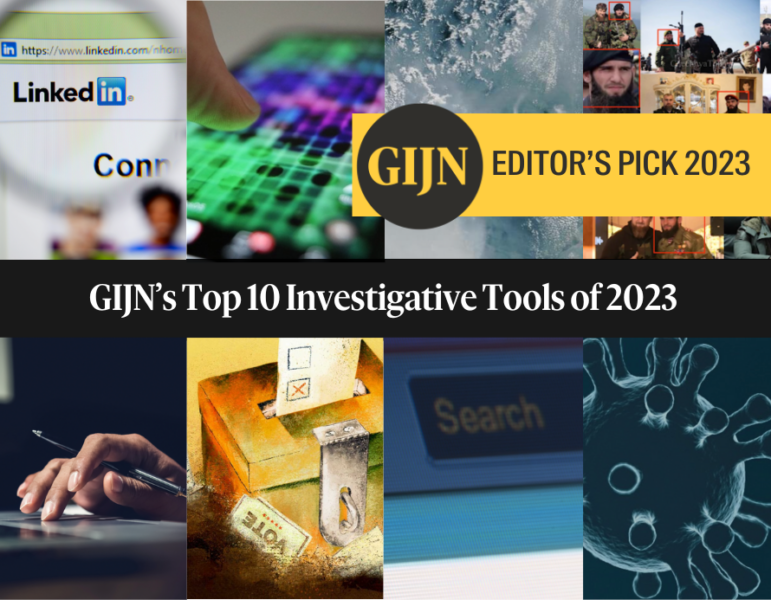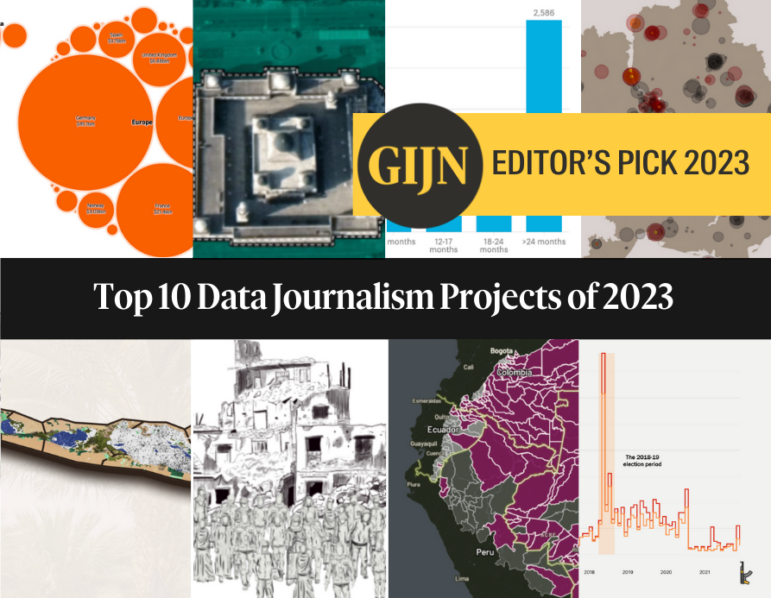

Image: Shutterstock
Center for Cooperative Media’s Top 10 Journalism Collaborations of 2023
Every year, I spent a few days in December looking back over all the collaborative journalism projects that the Center for Cooperative Media at Montclair State University tracked in the previous 12 months.
And every year, I’m amazed to see how partnerships can enhance journalism and its impact.
Of course, 2023 was no different. This was a year that included several big international investigations, regional partnerships, and multilingual collaborations.
So, let’s get into it.
1. Cyprus Confidential
The International Consortium of Investigative Journalists (ICIJ) is one of the most impactful journalism organizations on this planet. Period, full stop.
ICIJ consistently produces stories that expose corruption, change laws and improve lives. The latest is the Cyprus Confidential investigation, led by ICIJ and involving 68 media partners around the world. Another collaborative heavyweight, the Organized Crime and Corruption Reporting Project (OCCRP) played a key role.
The investigation examined how Cyprus-based financial services firms have allowed Russian elite — including people close to President Vladimir Putin — to shelter their wealth. That money was also shielded from the massive sanctions that Russia faced after it invaded Ukraine last year.
2. The Bruno and Dom Project
Forbidden Stories is an organization based in France that works in collaboration with journalists around the world to pick up investigations started by murdered journalists. The Bruno and Dom Project picked up where British journalist Dom Phillips and his guide and friend Bruno Pereira left off investigating illegal fishing in Brazil after they were murdered in June 2022.
Forbidden Stories and its partners spent a year investigating the industry, which “threatens the Amazon’s resources and the survival of the indigenous populations that Pereira defended,” ultimately revealing organized crime activity behind their deaths.
More than 50 journalists from 16 news organizations worked with Forbidden Stories on the project.

In a photo taken by Bruno Pereira, Dom Phillips interviews a fisherman from the Javari Valley, two days before the murder. Image: Screenshot, Forbidden Stories, TV Globo, Globoplay
3. NarcoFiles
Drug trafficking is a global business, but the problems it causes are most acutely felt in developing nations. The NarcoFiles: The New Criminal Order examined the impact of organized crime and “drug trade’s tentacles of violence, corruption, environmental destruction, and economic instability.”
The investigation was led by the OCCRP along with the Centro Latinoamericano de Investigación Periodística (CLIP), Vorágine, and Cerosetenta / 070. The organizations gained early access to the data from Distributed Denial of Secrets and Enlace Hacktivista.
More than 40 other media outlets including journalists from 23 countries worked on the investigation, chiefly in Latin America but also Europe and the United States.
4. Inundated
Inundated is a collaboration coordinated by the Institute for Nonprofit News published in August 2023. It examined flooding-related issues in Chicago, Milwaukee, Minnesota, and Detroit, featuring reporting from INN members Ensia, Grist, Wisconsin Watch, Planet Detroit, Sahan Journal, and Borderless.
INN director of collaborations Bridget Thoreson said that the series’ reporting was republished by 30 organizations, including national partners the Guardian and Inside Climate News, and participating journalists were interviewed about their work on NPR’s Here and Now and Latino Voices from WTTW Chicago. Series reporting by Kari Lydersen for Ensia was featured in a PBS Climate Virtual Town Hall on flooding, co-hosted by Great Lakes Now and Ideastream.
The series attracted more than 130,000 unique visitors from the participating newsrooms and national republication partners, plus audiences at 15 additional newsrooms and 13 non-news organizations. It was also featured in Inside Climate News’ newsletter, which has 300,000 subscribers.
5. The Rural News Network’s Speaking Out
Speaking Out: Rural Communities of Color Changing the Narrative is another project shepherded by INN. It focused on the nearly 14 million people of color who live in rural America and face unique challenges such as navigating racism in real estate, environmental regulation, and the justice system to gaining access to healthcare and broadband.
The project was produced by the Rural News Network, a collaborative launched earlier in 2023 by INN.

A story in the Sierra Nevada Ally that formed part of a Rural News Network collaborative investigation examines a lithium mine project near Fort McDermitt Indian Reservation in Nevada, where regional Indigenous tribes say they were not properly consulted by the government about the project. Image: Screenshot, Alejandra Rubio, Sierra Nevada Ally
Dan Haugen, managing editor of Energy News Network, served as lead editor on the series. For nearly three months, he worked with 17 other journalists and editors on the project that covered stories on the ground in five states and Puerto Rico on behalf of these six RNN newsrooms: Energy News Network, Flatwater Free Press, Mississippi Free Press, New Mexico In Depth, Religion News Service, and Sierra Nevada Ally. Read more about the collaboration here.
6. The Predator Files
The Predator Files was an investigation based on hundreds of confidential documents obtained by Mediapart and Der Spiegel and analyzed with help from Amnesty International’s Security Lab that showed the pervasive use of spyware. The project was coordinated by the European Investigative Collaborations (EIC) network and involved 15 media organizations.
The main finding: European companies have — for years — supplied dictators around the world with cyber-surveillance tools used against dissenters and others.
7. Oklahoma Media Center’s Ecosystem Engagement Project
This one is on the list because it combines the infrastructure of an existing news collaborative with an ecosystem-wide research effort.
The Oklahoma Media Center’s ecosystem engagement project had an initial research goal to find out where marginalized people in rural and metro areas get their local news, why they believe or trust information, and what would make them financially support local journalism. The project funded a statewide study, which was executed this year and released in September by the collaborative. Additionally, training was provided by Trusting News to help collaborating newsrooms execute experiments aimed at increasing the trust and support of local news.
The project culminated with US$100,000 in grants given to a dozen Oklahoma news organizations in an “Ecosystem Engagement Fund” cohort to implement data-driven projects designed to bolster the trust and sustainability of local news, all of which were based on the research. Results will be shared in 2024.
8. URL Media
I know, I know, I had URL Media on last year’s list. But their growth and industry-leading collaboration is stunning and important to note.
URL is now up to 27 partners, using a model that “focuses on empowering and building a network of high-performing BIPOC media organizations that join together to share resources, knowledge, content and revenues to promote expansion, enhance performance, and expand revenue streams for long term sustainability.” (I took that from a recent email they sent to partners and friends.) They are approaching 25 million users across their network’s platforms (!!!) and sold US$1 million in advertising for their partner organizations in 2023.
URL is now supported by the John S. and James L. Knight Foundation, Democracy Fund, Ford Foundation, Archewell Foundation, and the John D. and Catherine T. MacArthur Foundation. It employs 12 full-time employees.
9. CalMatters and Catchlight’s Work on Unhoused Californians
CalMatters is no stranger to this top 10 list, having been a leader on the West Coast when it comes to collaborations for years. I included this partnership because of the organization’s partnership with Catchlight — and because I think you’ll be hearing a lot more about Catchlight over the next couple of years.
The two organizations teamed up for a year to document three street medic teams in Los Angeles, Bakersfield, and Redding working to help some of California’s 170,000 unhoused people access medical care. Larry Valenzuela was the CatchLight Fellow working as a CalMatters photographer as part of CatchLight’s Local Visual Desk. Catchlight has recently landed large grants from the John S. and James L. Knight Foundation and the Catherine T. and John D. MacArthur Foundation to help expand this kind of work, so keep an eye out for more in 2024.
10. The Vulkan Files
The Vulkan Files is a collaborative investigative reporting project focused on analyzing thousands of leaked documents from the Russian company NTC Vulkan, known for its specialization in information security.

Three Russian secret service agencies use products and hacking tools produced by the Moscow-based company NTC Vulkan. Image: Screenshot, Der Spiegel Graphics, Wikimedia Commons
The leaked documents were initially provided to the German newspaper Süddeutsche Zeitung by a whistleblower and were subsequently analyzed by a consortium of journalists led by Paper Trail Media and Der Spiegel. The leaked documents were later authenticated by five Western intelligence agencies and several independent cybersecurity experts. The consortium included major news organizations such as the Guardian, Le Monde, and The Washington Post, along with several other media outlets.
The Vulkan Files investigation brought to light crucial information regarding Vulkan’s connections with Russian hacker groups like Sandworm and Cozy Bear, and their role in global and domestic cyberwarfare strategies. It’s a clear example of the power of collaborative investigative journalism in uncovering complex international stories, particularly those involving cybersecurity and international politics.
Collaboratives to Watch, Honorable Mentions
There are too many to name, but here are a few more collaborative initiatives and reporting projects you should know about or keep an eye on:
- The International Consortium of Investigative Journalists celebrated 10 years since its first big Offshore Leaks investigation in 2023 — check out this post: “Ten years of exposing the financial secrets of some of the world’s most powerful people.”
- The Arena for Journalism in Europe’s new Collaborative Desk is an initiative that “aims to provide the tools and support journalists need to enable their cross-border teams to collaborate successfully.”
- The Philadelphia Journalism Collaborative, which was just announced this fall as the next iteration of local collaborative journalism work that Resolve Philly has led in the city for the last several years.
- Alison Levine is a wonder woman, and everyone needs to keep tabs on what she’s building in Delaware through the Local Journalism Initiative, mainly the Delaware Journalism Collaborative and Spotlight Delaware.
- A large-scale collaborative journalism project called Amazon Underworld, led by Bram Ebus, exposed the extent of organized crime in the Amazon, which is largely ungoverned.
- Deforestation Inc., a collaborative investigation led by ICIJ, revealed flaws in environmental auditing and certification programs, uncovered how major environmental auditing firms certified over 340 clients as sustainable despite obvious environmental damage, and highlighted the unregulated nature of the industry.
- The Indiana Local News Initiative is a new collaborative effort that aims to enhance local journalism and democracy in Indiana. The ILNI is supported by 11 philanthropies with almost US$10 million raised, and more than 1,000 Hoosiers across 79 counties participated in a study expressing the need for more local news.
This post was originally published on Medium and is reprinted here with permission. It has been lightly edited for style.
 Stefanie Murray is the director of the Center for Cooperative Media at Montclair State University. Contact her at murrayst@montclair.edu.
Stefanie Murray is the director of the Center for Cooperative Media at Montclair State University. Contact her at murrayst@montclair.edu.









